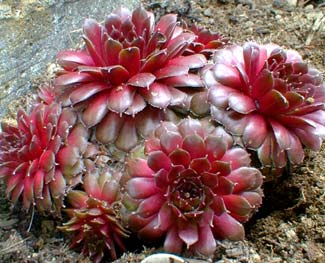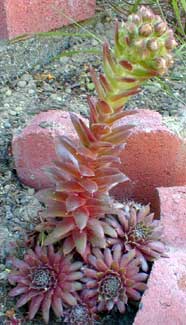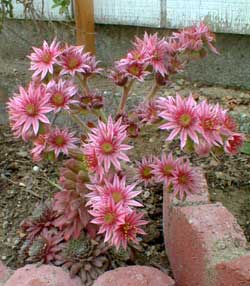
'Alpha'
Houseleek
or Stone Rose
"All Houseleeks known
Possess a charm that's quite their own."
-Walter Ingwersen,
1943
1943
The houseleek variety 'Alpha' aka 'Aipha' has very red leaves in autumn, chocolate colored in winter, & bluish green darkening to red spring through summer.
It has such tight little leaves in each medium-sized rosette that it almost looks like a pile of reddish brown pompoms. It has a whisper of cobwebbing derived from the Cobweb Houseleek S. arachnoideum in its hybrid history. Its other key parent was S. tectorum, the common or roof houseleek.
 This is a popular old strain in its own right, as well as a parent of many later hybrids. It was developed by Georg Arends (1863-1952). His three most important achievements with semperviva are 'Alpha,' 'Beta,' & 'Gamma,' introduced to gardening in 1929.
This is a popular old strain in its own right, as well as a parent of many later hybrids. It was developed by Georg Arends (1863-1952). His three most important achievements with semperviva are 'Alpha,' 'Beta,' & 'Gamma,' introduced to gardening in 1929.Georg Arends founded a world-famed nursery in Ronsdorf, Germany, in 1888. There is a famous pink rose named Georg Arends, as well as a bright rose-red Azalea, plus other plants baring his name. We have in our garden a monkshood that bares his name, A. carmichaelii 'Arendsii.'
Houseleeks were believed to reflect the shape & appearance the eyes of the god Thor or Jupiter, hence sometimes called Jupiter's Eyes or the Bullock's Eyes.
 The names Thor's Beard, Thorsbeard, Thunderbeard, or Jovibarba may not at first be as obvious in its origin. The "beard" is the phalic flower-stalk which for "Alpha" rises out of the houseleeks in June.
The names Thor's Beard, Thorsbeard, Thunderbeard, or Jovibarba may not at first be as obvious in its origin. The "beard" is the phalic flower-stalk which for "Alpha" rises out of the houseleeks in June.Just such a phallic stalk can be seen in the second photo. Beard & phallus are no longer considered similar in nature, but they once were, & beards were often tied round with ribbons to stiffen them into long phalluses of the chin, akin to those worn by Pharaohs.
The phallic meaning of houseleeks was recalled in folk belief, it being a practice to grow houseleeks at the front door so that they would be the first thing a man saw when he returned from the fields. This was believed to increase the sexual prowess of the man of the house, for which reason houseleeks were known in Dorset as "Welcome Husband."
By July the phallic appearance is over, & the head of the stalk bursts into glorious bright pink blooms, as in the third photo.
In Scotland they were called, among other names, Foose or Fows, which is a wheel; & rustics of Ireland & Scotland perceived something of the Moon in the roundness of the rosettes, associating houseleeks with moon-magic, fancying the plant mystically capable of deflecting black sorcery.